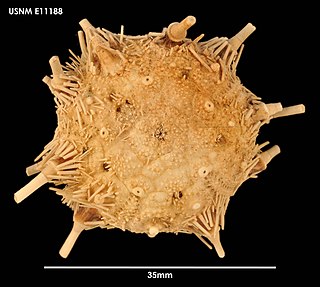Related Research Articles

Temnopleuridea is an infraorder of sea urchins in the order Camarodonta. They are distinguished from other sea urchins by the presence of large fused plates on top of the feeding lantern. The test is usually sculpted to some degree, and has perforated tubercles.

The Echinothurioida are an order of sea urchins in the class Echinoidea. Echinothurioids are distinguished from other sea urchins by the combination of a flexible test and hollow spines. The membrane around the mouth contains only simple plates, in contrast to the more complex mouth parts of their close relatives, the Diadematoida. They are nearly all deepsea dwellers.

The Camarodonta are an order of globular sea urchins in the class Echinoidea. The fossil record shows that camarodonts have been in existence since the Lower Cretaceous.
Acanthocidaris maculicollis is a species of sea urchin of the family Cidaridae. Their armour is covered with spines. It came from the genus Acanthocidaris and lives in the sea. Acanthocidaris hastingeria was first scientifically described in 1904 by de Meijere.
Antrechinus nordenskjoldi is a species of sea urchin of the family Urechinidae. Their armour is covered with spines. It is placed in the genus Antrechinus and lives in the sea. Antrechinus nordenskjoldi was first scientifically described in 1905 by Ole Theodor Jensen Mortensen.

Apatopygus occidentalis is a species of sea urchin of the family Apatopygidae. Their armour is covered with spines. It is placed in the genus Apatopygus and lives in the sea. Apatopygus occidentalis was first scientifically described in 1928 by Hubert Lyman Clark, American zoologist.

Apatopygus recens is a species of sea urchin of the family Apatopygidae. Their armour is covered with spines. It is placed in the genus Apatopygus and lives in the sea. Apatopygus recens was first scientifically described in 1836 by Milne-Edwards, French zoologist.
Aporocidaris antarctica is a species of sea urchin of the family Ctenocidaridae. Their armour is covered with spines. It is placed in the genus Aporocidaris and lives in the sea. Aporocidaris antarctica was first scientifically described in 1909 by Ole Theodor Jensen Mortensen, Danish professor. It has a circum-Antarctic distribution.

Aporocidaris eltaniana is a species of sea urchin of the family Ctenocidaridae. Their armour is covered with spines. It is placed in the genus Aporocidaris and lives in the sea. Aporocidaris eltaniana was first scientifically described in 2000 by Mooi, David, Fell & Choné. It is found in the waters off Livingston Island in the South Shetland Islands at depths between 884 and 1,437 m.
Araeosoma belli is a species of sea urchin of the family Echinothuriidae. Their armour is covered with spines. It is placed in the genus Araeosoma and is found throughout the Caribbean Sea as well as areas around the Gulf of Mexico. Araeosoma belli was first scientifically described in 1903 by Ole Theodor Jensen Mortensen, a Danish zoologist.
Araeosoma violaceum is a species of sea urchin of the family Echinothuriidae. Its armour is covered with spines. It is placed in the genus Araeosoma and lives in the sea. A. violaceum was first scientifically described in 1903 by Ole Theodor Jensen Mortensen.
Caenopedina indica is a species of sea urchins of the Family Pedinidae. Their armour is covered with spines. Caenopedina indica was first scientifically described in 1903 by de Meijere.
Calocidaris micans is a species of sea urchins of the Family Cidaridae. Their armour is covered with spines. Calocidaris micans was first scientifically described in 1903 by Ole Mortensen.

Chaetodiadema granulatum is a species of sea urchins of the Family Diadematidae. Their armour is covered with long and slender spines, and the test is quite flattened.
Cidaris nuda is a species of sea urchins of the Family Cidaridae. Their armour is covered with spines. Cidaris nuda was first scientifically described in 1903 by Ole Mortensen.

Chaetodiadema is a genus of sea urchins of the Family Diadematidae. Their armour is covered with spines.

The Echinothuriidae are a family of sea urchins in the order Echinothurioida. Due to their soft skeletons, most are called "leather urchins", but species in the genus Asthenosoma are also known as "fire urchins" due to their bright colors and painful, venomous sting.
Athanas areteformis is a species of small alpheid shrimp from the Indo-West Pacific.

Gracilechinus is a genus of sea urchins in the family Echinidae.

Araeosoma is a genus of deep-sea sea urchins in the family Echinothuriidae.
References
- ↑ Kroh, A. (2010). Apatopygus echinobrissoides (de Meijere, 1903). In: Kroh, A. & Mooi, R. (2010) World Echinoidea Database. at the World Register of Marine Species.
 | This article about a sea urchin is a stub. You can help Wikipedia by expanding it. |